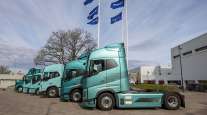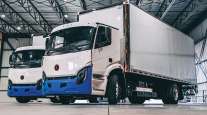Contributing Writer
Electric Truck Integration Poses Challenges for Fleets, Study Shows

[Stay on top of transportation news: Get TTNews in your inbox.]
Many fleets are looking to integrate electric trucks into their operations but are stymied by a series of obstacles that will slow the shift from diesel vehicles.
That’s the conclusion of a new report issued by the California Trucking Association, environmental nonprofit Ceres and Navigant Research. Amazon.com funded the study.
“Continuous improvements in EV technologies are producing lower costs, greater range and faster charging, further enabling the use of EVs in the commercial transportation sector,” according to the May 5 report. “Though the trend is encouraging, fleet operators face challenges that, if not confronted, may slow this progress.”
#EVs are critical to tackling climate change, and companies are eager to lead the way. New analysis shows how utilities, regulators, and policymakers can help companies accelerate electrification.
Report by Ceres, @Caltrux, @NavigantRSRCH & @amazon: https://t.co/9y1V7cgBEC — Ceres (@CeresNews) May 5, 2020
Electric trucks are nearing commercialization because the main cost of EVs — the battery — has declined as much as 80% over the past eight years, according to the CTA/Ceres report. That is expected to drop an additional 50% over the next decade, which would put upfront costs of many EVs below their diesel counterparts by 2030, the report said.
Additionally, recurring costs such as fuel — in this case electricity to power the vehicles — and maintenance are lower than internal combustion trucks, the report said. That will provide significant operational cost savings and encourage adoption.
But significant hurdles still remain.
Charging, for example, takes far longer than filling the fuel tanks of a diesel truck, the report noted.

Host Seth Clevenger speaks with Mike Perkins and Derrick Loo, test drivers at Peloton Technology, one of the companies at the forefront of developing truck platooning systems. Hear a snippet, above, and get the full program by going to RoadSigns.TTNews.com.
“EV charge times must be minimized and predictable, and reliability must be consistent with conventional fossil fuel-powered vehicles,” the report said.
Additionally, fleet operators know how to keep a diesel fleet supplied with fuel. They need help learning how to manage an electric fleet, how to navigate issues such as power outages and how to work with facility property owners, vehicle leasing companies and other service operators to integrate electric vehicles into their operations. Property owners, for example, would have to allow the construction of high-voltage charging infrastructure to keep the trucks powered.
Utilities also present a challenge to fleet operators. The fleets surveyed by the study’s authors said that utility programs need more transparency, flexibility and speed. Moreover, “Fleet operators need data and information upfront to improve decision-making and to optimize their fleet-electrification strategies,” the report said.
Fleet operators also need a utility contact who is an EV expert to efficiently provide the needed rate information and other services electric truck users will require.
Fleets also will need technology interoperability open standards for hardware and software that will allow operators to invest in charging infrastructure “that is future-proofed and scalable,” the report said.
The report’s findings are “generally well-aligned with the issues we have been working on,” said Bill Van Amburg, executive vice president of Calstart, a Pasadena, Calif., nonprofit clean transportation industry consortium.

Van Amburg
Utilities must address many of the key issues that would make scaling of truck electrification easier and faster for fleets, Van Amburg said.
“Really streamlining their processes and simplifying their rate structures and requirements would be of tremendous help,” he said. “The gorilla in the room is the fact that utilities generally cannot act independently of their regulatory structure. Utilities are regulated for their rates at the state level.”
California is one of the states encouraging utilities to invest proactively in infrastructure and revising their rates. “[But] the nation is a crazy quilt of different approaches,” Van Amburg said.
But the trucking industry in the state wants a smooth transition.
“As operators of commercial medium and heavy-duty vehicles, California truck drivers have a unique set of needs that must be addressed to ensure any transition to EVs is as efficient, safe and cost-effective as possible,” said California Trucking Association CEO Shawn Yadon.

Yadon
California is pushing the use of electric trucks, setting a series of targets for adoption. It wants to have an estimated 4,000 zero-emission trucks on the state’s roads by the end of 2024.
A draft rule issued by the California Air Resources Board in April would require 5% of new Classes 7-8 tractor sales to be zero-emission vehicles such as electric or fuel cell trucks by the end of 2024. Such vehicles would be 9% of Classes 4-8 straight truck sales by the same time period.
That ramps up to 30% of Classes 7-8 tractor sales and 50% of Classes 4-8 straight truck sales by the end of 2030.
Electric trucks already are operating in small numbers in the state. Both logistics firm NFI and Penske Truck Leasing are testing Freightliner electric trucks. NFI will start using the electric version of Volvo’s VNR truck later this year. Frito-Lay North America Inc. plans to test Tesla’s electric semi at its facility in Modesto, Calif., this year or next, according to CARB.
Want more news? Listen to today's daily briefing:




